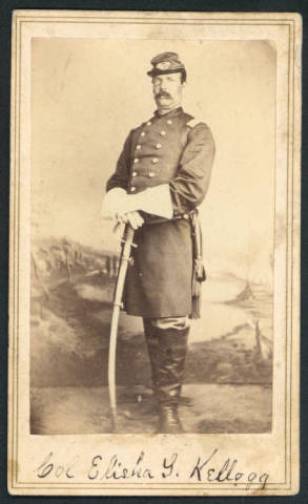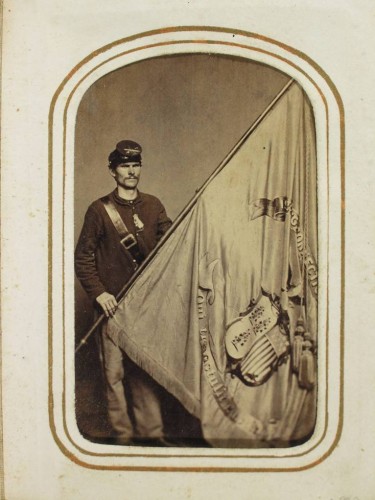by Richard Malley
Connecticut’s response to the firing on Fort Sumter and Lincoln’s call for three-month volunteer troops was immediate and significant. Throughout the state, men of military age enlisted for what most people thought was simply going to be a show of strength that would dissuade southerners from supporting secession.

Colonel Elisha S. Kellogg, Second Connecticut Heavy Artillery. Photograph by Bowdoin, Taylor & Co., Alexandria, VA, 1864 – Connecticut Historical Society and Connecticut History Online
In the months following the sobering Union defeat at the first battle of Bull Run in July 1861, additional units were recruited. In the summer of 1862, yet another infantry regiment was organized—the Nineteenth Connecticut Volunteer Infantry. Some 815 men, drawn primarily from Litchfield County, trained for a few weeks under the stern guidance of Major Elisha S. Kellogg from Derby before the unit was whisked off to the Washington area for additional training and guard duty. In November 1863, the War Department ordered the Nineteenth to be reorganized as the Second Connecticut Volunteer Heavy Artillery Regiment, and officers were sent back to Connecticut to recruit new members to bring the unit up to proper strength.
In May 1864 the regiment traveled to Fredericksburg, thence on to the area near Cold Harbor, Virginia, about 10 miles northeast of Richmond. There they encountered stiff opposition from General Robert E. Lee’s Confederates. With General Ulysses S. Grant now in command, a new, more aggressive Union strategy sought to crush Confederate forces in Virginia and capture Richmond. Though effective, Grant’s tactics resulted in higher casualty rates.
On June 1 the regiment, which thus far had seen little action, found itself on the front lines, facing seasoned Confederate forces that were well entrenched behind an elaborate complex of earthworks. In what Grant later admitted was a mistake, a full frontal assault of the Confederate line was made, and the Second Connecticut Heavies, once again operating as an infantry unit, found themselves in the thick of the fight. The physically imposing Elisha Kellogg, now commanding the unit, led the charge across open ground toward the enemy. A hurricane of lead cut down scores of the attackers and when the unit pulled back, Colonel Kellogg lay dead on the field, one of some 118 men killed in the assault. In all, 323 men from the regiment were killed or wounded. The survivors were stunned by this slaughter, but they continued to serve in the campaign.
By the fall of 1864 the Second found itself supporting Philip Sheridan’s operations in the Shenandoah Valley before rejoining Grant in the Petersburg campaign. In April 1865 the regiment marched north through the ruins of Richmond, and on September 5, 1865, the men of the Second mustered out. For many veterans of the Second, the assault at Cold Harbor would be the most terrible memory of the conflict.
Richard Malley is Head of Collections at the Connecticut Historical Society.
© Connecticut Public Broadcasting Network and Connecticut Historical Society. All rights reserved. This article originally appeared on Connecticut History | WNPR News
Note: ConnecticutHistory.org does not edit content originally published on another platform and therefore does not update any instances of outdated content or language.









